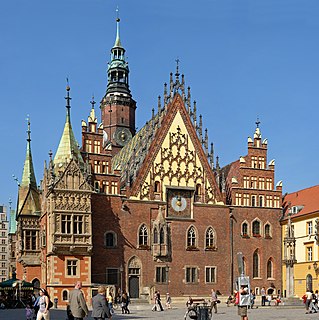| Stara Rudna | |
|---|---|
| Village | |
| Coordinates: 51°29′29″N16°16′58″E / 51.49139°N 16.28278°E Coordinates: 51°29′29″N16°16′58″E / 51.49139°N 16.28278°E | |
| Country | |
| Voivodeship | Lower Silesian |
| County | Lubin |
| Gmina | Rudna |
| Elevation | 130 m (430 ft) |
| Population | 140 |
Stara Rudna [ˈstara ˈrudna] (German : Alt Raudten) is a village in the administrative district of Gmina Rudna, within Lubin County, Lower Silesian Voivodeship, in south-western Poland. [1] Prior to 1945 it was in Germany.

German is a West Germanic language that is mainly spoken in Central Europe. It is the most widely spoken and official or co-official language in Germany, Austria, Switzerland, South Tyrol (Italy), the German-speaking Community of Belgium, and Liechtenstein. It is also one of the three official languages of Luxembourg and a co-official language in the Opole Voivodeship in Poland. The languages which are most similar to German are the other members of the West Germanic language branch: Afrikaans, Dutch, English, the Frisian languages, Low German/Low Saxon, Luxembourgish, and Yiddish. There are also strong similarities in vocabulary with Danish, Norwegian and Swedish, although those belong to the North Germanic group. German is the second most widely spoken Germanic language, after English.
Gmina Rudna is a rural gmina in Lubin County, Lower Silesian Voivodeship, in south-western Poland. Its seat is the village of Rudna, which lies approximately 14 kilometres (9 mi) north of Lubin and 69 km (43 mi) north-west of the regional capital Wrocław.

Lubin County is a unit of territorial administration and local government (powiat) in Lower Silesian Voivodeship, south-western Poland. It came into being on January 1, 1999, as a result of the Polish local government reforms passed in 1998. The county covers an area of 712 square kilometres (274.9 sq mi). Its administrative seat and largest town is Lubin, and its only other town is Ścinawa.
It lies approximately 12 kilometres (7 mi) north-east of Lubin, and 67 kilometres (42 mi) north-west of the regional capital Wrocław. The village has a population of 140.

Wrocław is a city in western Poland and the largest city in the historical region of Silesia. It lies on the banks of the River Oder in the Silesian Lowlands of Central Europe, roughly 350 kilometres (220 mi) from the Baltic Sea to the north and 40 kilometres (25 mi) from the Sudeten Mountains to the south. The population of Wrocław in 2018 was 639,258, making it the fourth-largest city in Poland and the main city of Wrocław agglomeration.
The place, originally called Ruda, may have developed out of an old Slavic castle and a church built in approximately 1100 by Piotr Włostowic of Dunin, though no documents are saved.

Piotr Włostowic, also known as Peter Wlast or Włost) was a Polish noble, castellan of Wrocław, and a ruler (możnowładca) of part of Silesia. From 1117 he was voivode (palatyn) of the king of Poland, Bolesław III Wrymouth. Part of the Łabędzie family, and son of Włostowic, he is likely to have been related to older princes of Silesia. His lands included the territories near Mount Ślęża and Piasek Island near Wrocław. The Dunin clan of noble families claims descent from him.
The Polish surname Dunin originated with the 12th century with Piotr Włost Dunin. He was Palatine of Poland and the castellan of Wroclaw (Silesia), as well as, Brother in law of Duke Bolesław III Wrymouth. The coat of arms is the Łabędź (swan). See: Duninowie family.
Christian Knorr von Rosenroth, a Christian Hebraist, was born in Alt Raudten in 1631.

Christian Knorr von Rosenroth was a German Christian Hebraist and Christian Cabalist born at Alt-Raudten in Silesia. After having completed his studies in the universities of Wittenberg and Leipzig, he traveled through the Netherlands, France, and England. At Amsterdam, he became acquainted with an Armenian prince, with the chief Rabbi, Meier Stern, Dr. John Lightfoot and Henry More. Influenced by them, and others, he studied Oriental languages, chemistry, and the cabalistic sciences. On his return, he settled at Sulzbach where he became the privy counsellor of Christian Augustus, Count Palatine of Sulzbach. He devoted himself to the study of Hebrew. Later he became a student of the Kabbalah, in which he believed to find proofs of the doctrines of Christianity.
A Christian Hebraist is a scholar of Hebrew who comes from a Christian family background/belief, or is a Jewish adherent of Christianity. The main area of study is that commonly known as the Old Testament to Christians, but Christians have occasionally taken an interest in the Talmud, and Kabbalah.


